CHEVROLET VENTURE 2002 1.G Manual Online
Manufacturer: CHEVROLET, Model Year: 2002, Model line: VENTURE, Model: CHEVROLET VENTURE 2002 1.GPages: 486, PDF Size: 3.19 MB
Page 81 of 486
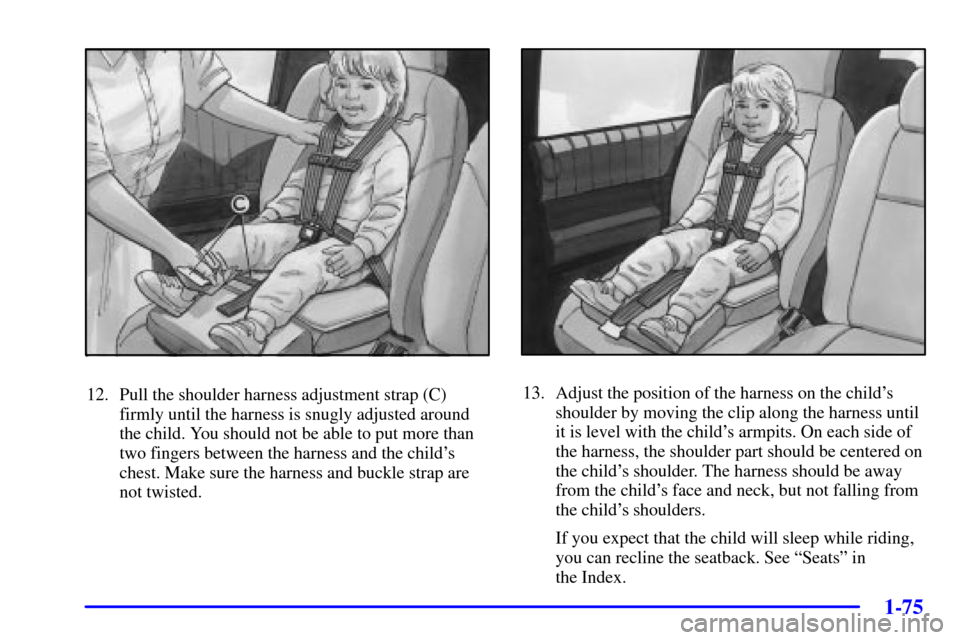
1-75
12. Pull the shoulder harness adjustment strap (C)
firmly until the harness is snugly adjusted around
the child. You should not be able to put more than
two fingers between the harness and the child's
chest. Make sure the harness and buckle strap are
not twisted.13. Adjust the position of the harness on the child's
shoulder by moving the clip along the harness until
it is level with the child's armpits. On each side of
the harness, the shoulder part should be centered on
the child's shoulder. The harness should be away
from the child's face and neck, but not falling from
the child's shoulders.
If you expect that the child will sleep while riding,
you can recline the seatback. See ªSeatsº in
the Index.
Page 82 of 486
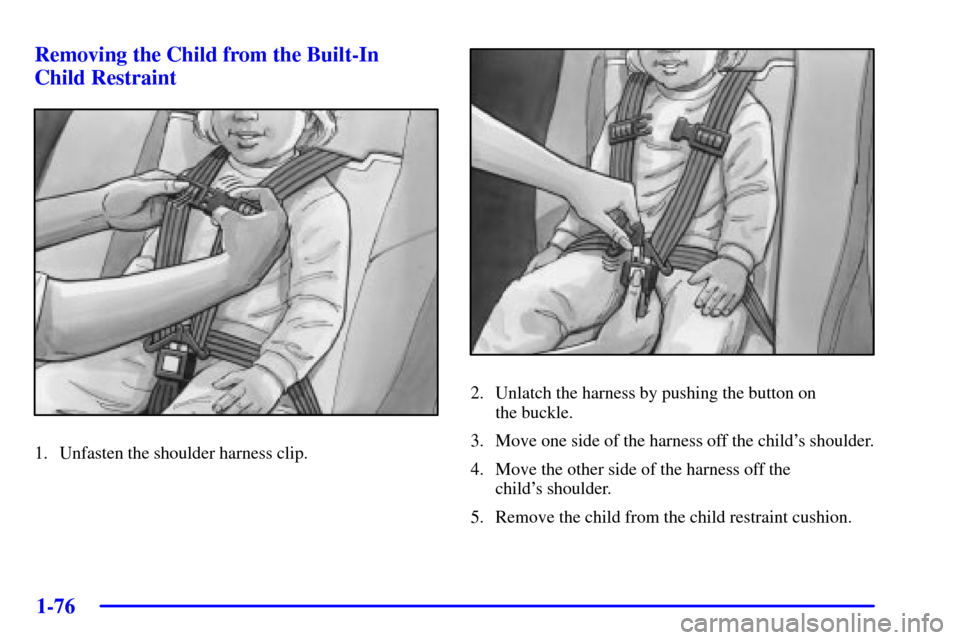
1-76 Removing the Child from the Built-In
Child Restraint
1. Unfasten the shoulder harness clip.
2. Unlatch the harness by pushing the button on
the buckle.
3. Move one side of the harness off the child's shoulder.
4. Move the other side of the harness off the
child's shoulder.
5. Remove the child from the child restraint cushion.
Page 83 of 486
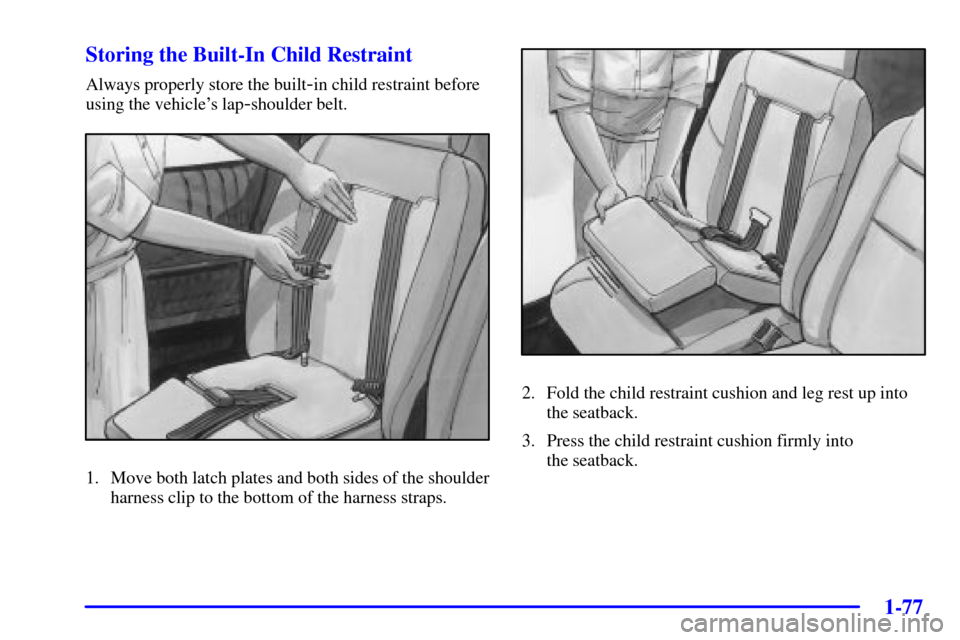
1-77
Storing the Built-In Child Restraint
Always properly store the built-in child restraint before
using the vehicle's lap
-shoulder belt.
1. Move both latch plates and both sides of the shoulder
harness clip to the bottom of the harness straps.
2. Fold the child restraint cushion and leg rest up into
the seatback.
3. Press the child restraint cushion firmly into
the seatback.
Page 84 of 486
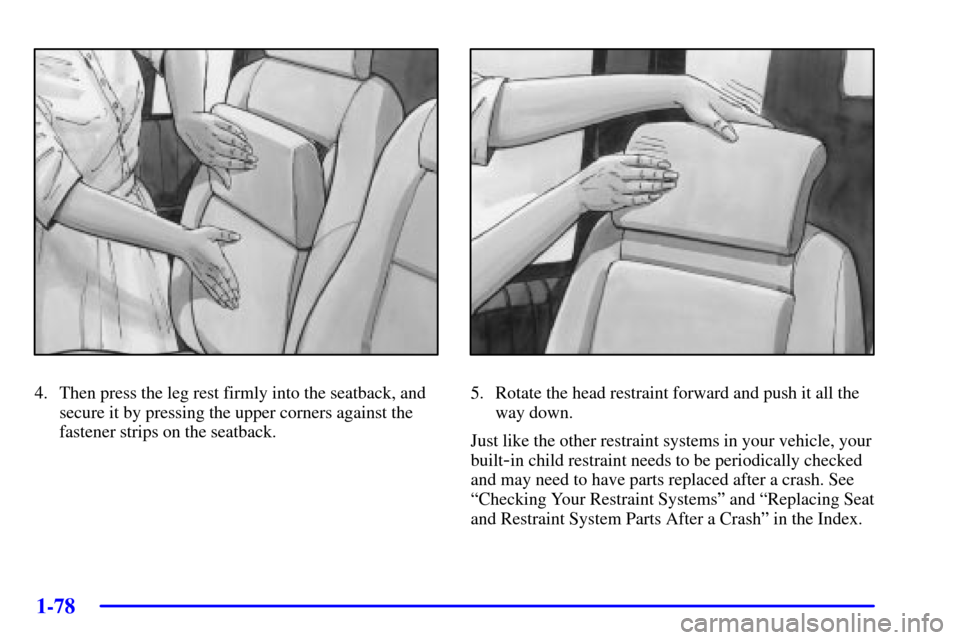
1-78
4. Then press the leg rest firmly into the seatback, and
secure it by pressing the upper corners against the
fastener strips on the seatback.5. Rotate the head restraint forward and push it all the
way down.
Just like the other restraint systems in your vehicle, your
built
-in child restraint needs to be periodically checked
and may need to have parts replaced after a crash. See
ªChecking Your Restraint Systemsº and ªReplacing Seat
and Restraint System Parts After a Crashº in the Index.
Page 85 of 486
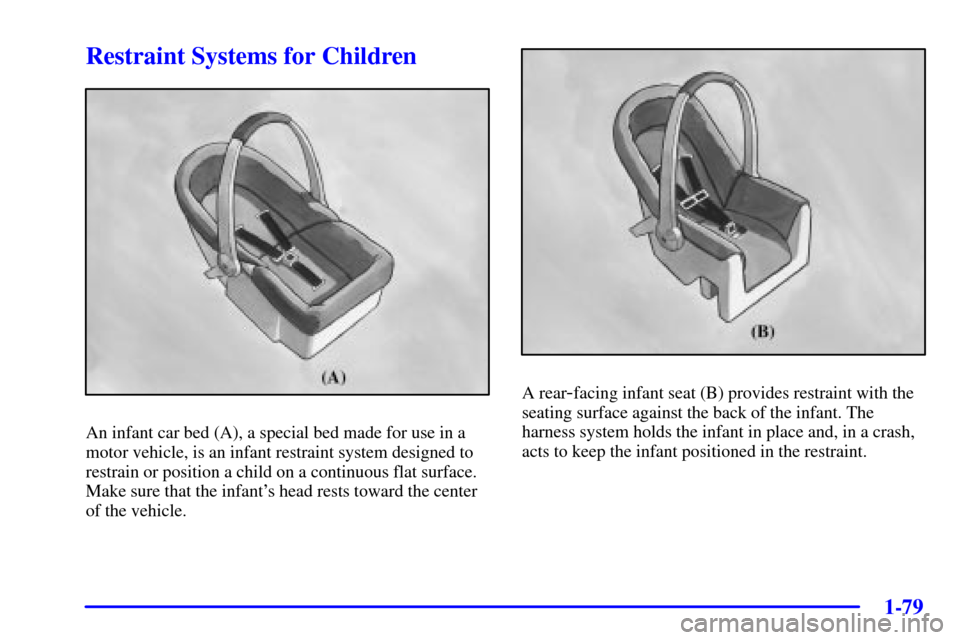
1-79
Restraint Systems for Children
An infant car bed (A), a special bed made for use in a
motor vehicle, is an infant restraint system designed to
restrain or position a child on a continuous flat surface.
Make sure that the infant's head rests toward the center
of the vehicle.
A rear-facing infant seat (B) provides restraint with the
seating surface against the back of the infant. The
harness system holds the infant in place and, in a crash,
acts to keep the infant positioned in the restraint.
Page 86 of 486
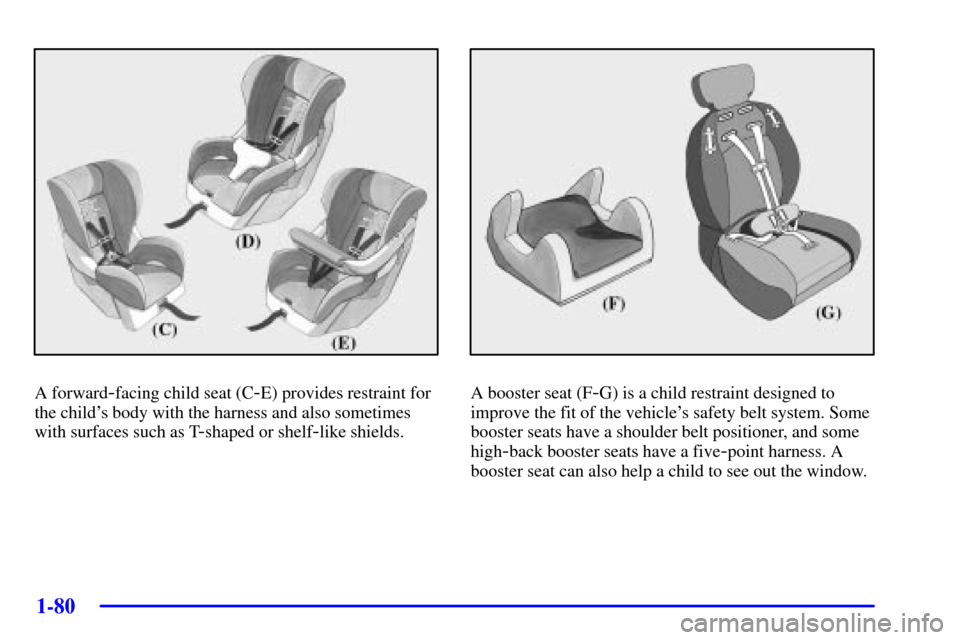
1-80
A forward-facing child seat (C-E) provides restraint for
the child's body with the harness and also sometimes
with surfaces such as T
-shaped or shelf-like shields.
A booster seat (F-G) is a child restraint designed to
improve the fit of the vehicle's safety belt system. Some
booster seats have a shoulder belt positioner, and some
high
-back booster seats have a five-point harness. A
booster seat can also help a child to see out the window.
Page 87 of 486
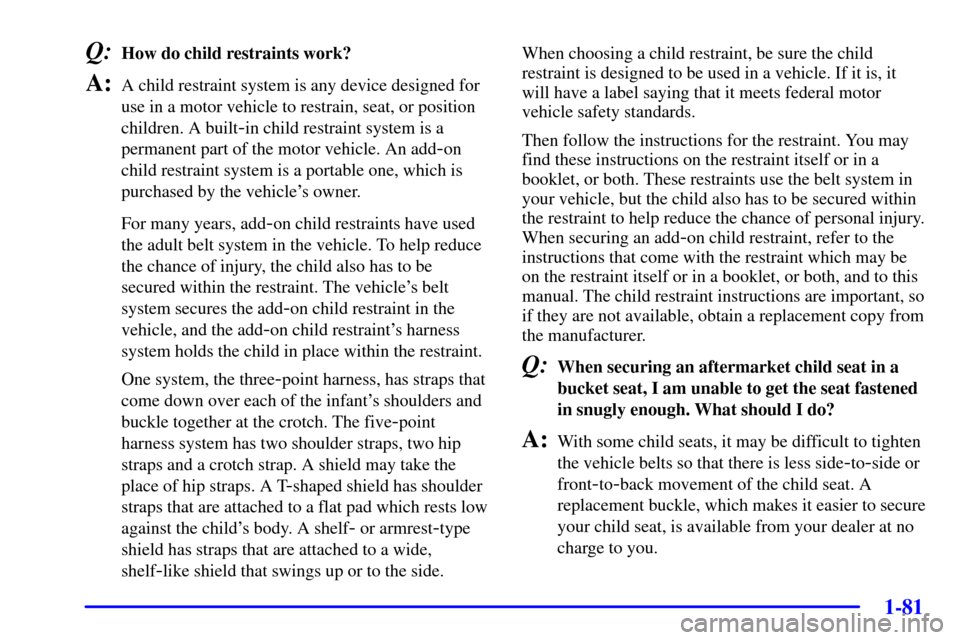
1-81
Q:How do child restraints work?
A:A child restraint system is any device designed for
use in a motor vehicle to restrain, seat, or position
children. A built
-in child restraint system is a
permanent part of the motor vehicle. An add
-on
child restraint system is a portable one, which is
purchased by the vehicle's owner.
For many years, add
-on child restraints have used
the adult belt system in the vehicle. To help reduce
the chance of injury, the child also has to be
secured within the restraint. The vehicle's belt
system secures the add
-on child restraint in the
vehicle, and the add
-on child restraint's harness
system holds the child in place within the restraint.
One system, the three
-point harness, has straps that
come down over each of the infant's shoulders and
buckle together at the crotch. The five
-point
harness system has two shoulder straps, two hip
straps and a crotch strap. A shield may take the
place of hip straps. A T
-shaped shield has shoulder
straps that are attached to a flat pad which rests low
against the child's body. A shelf
- or armrest-type
shield has straps that are attached to a wide,
shelf
-like shield that swings up or to the side.When choosing a child restraint, be sure the child
restraint is designed to be used in a vehicle. If it is, it
will have a label saying that it meets federal motor
vehicle safety standards.
Then follow the instructions for the restraint. You may
find these instructions on the restraint itself or in a
booklet, or both. These restraints use the belt system in
your vehicle, but the child also has to be secured within
the restraint to help reduce the chance of personal injury.
When securing an add
-on child restraint, refer to the
instructions that come with the restraint which may be
on the restraint itself or in a booklet, or both, and to this
manual. The child restraint instructions are important, so
if they are not available, obtain a replacement copy from
the manufacturer.
Q:When securing an aftermarket child seat in a
bucket seat, I am unable to get the seat fastened
in snugly enough. What should I do?
A:With some child seats, it may be difficult to tighten
the vehicle belts so that there is less side
-to-side or
front
-to-back movement of the child seat. A
replacement buckle, which makes it easier to secure
your child seat, is available from your dealer at no
charge to you.
Page 88 of 486
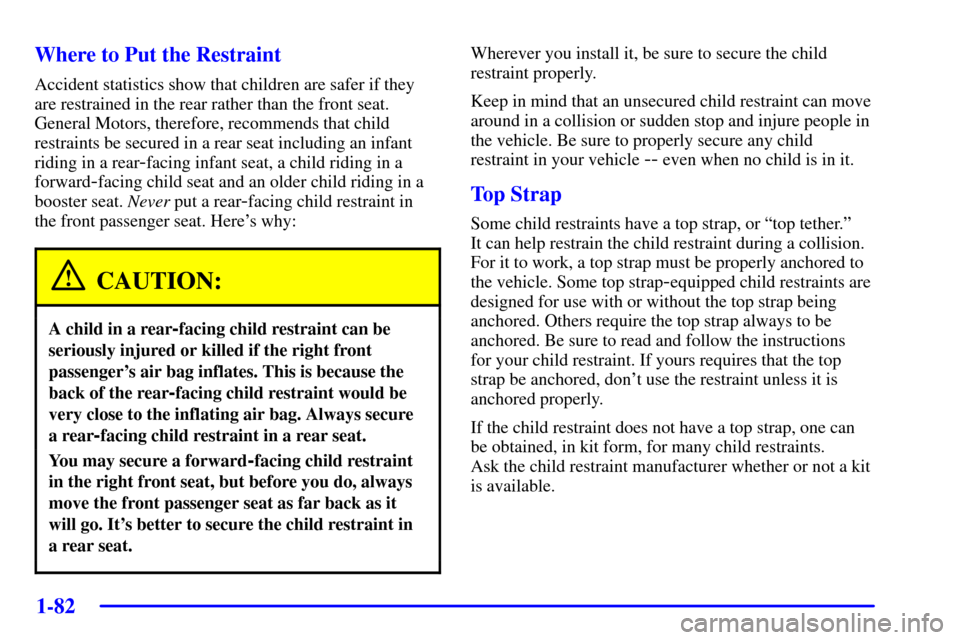
1-82 Where to Put the Restraint
Accident statistics show that children are safer if they
are restrained in the rear rather than the front seat.
General Motors, therefore, recommends that child
restraints be secured in a rear seat including an infant
riding in a rear
-facing infant seat, a child riding in a
forward
-facing child seat and an older child riding in a
booster seat. Never put a rear
-facing child restraint in
the front passenger seat. Here's why:
CAUTION:
A child in a rear-facing child restraint can be
seriously injured or killed if the right front
passenger's air bag inflates. This is because the
back of the rear
-facing child restraint would be
very close to the inflating air bag. Always secure
a rear
-facing child restraint in a rear seat.
You may secure a forward-facing child restraint
in the right front seat, but before you do, always
move the front passenger seat as far back as it
will go. It's better to secure the child restraint in
a rear seat.
Wherever you install it, be sure to secure the child
restraint properly.
Keep in mind that an unsecured child restraint can move
around in a collision or sudden stop and injure people in
the vehicle. Be sure to properly secure any child
restraint in your vehicle
-- even when no child is in it.
Top Strap
Some child restraints have a top strap, or ªtop tether.º
It can help restrain the child restraint during a collision.
For it to work, a top strap must be properly anchored to
the vehicle. Some top strap
-equipped child restraints are
designed for use with or without the top strap being
anchored. Others require the top strap always to be
anchored. Be sure to read and follow the instructions
for your child restraint. If yours requires that the top
strap be anchored, don't use the restraint unless it is
anchored properly.
If the child restraint does not have a top strap, one can
be obtained, in kit form, for many child restraints.
Ask the child restraint manufacturer whether or not a kit
is available.
Page 89 of 486
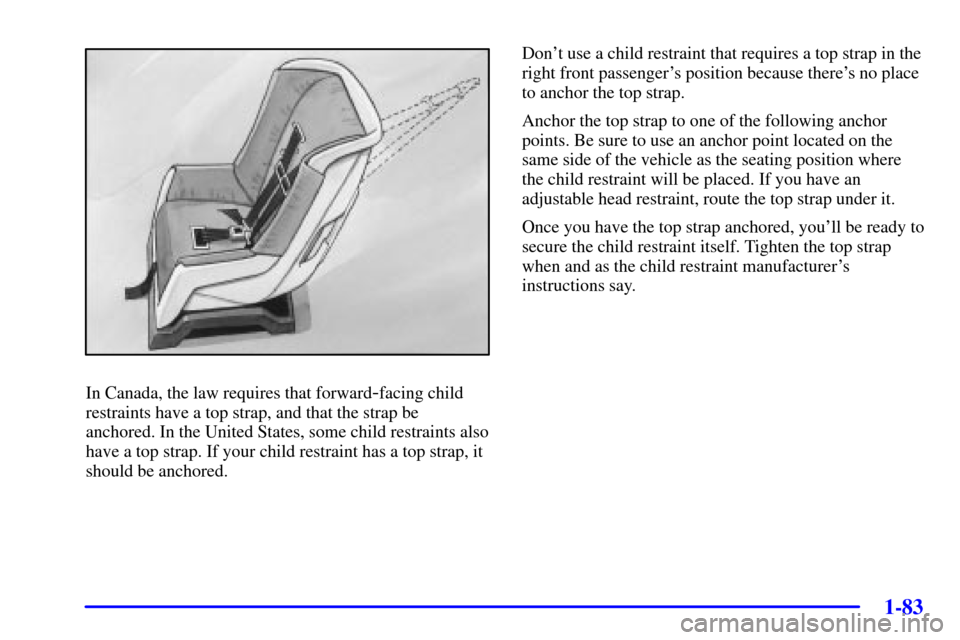
1-83
In Canada, the law requires that forward-facing child
restraints have a top strap, and that the strap be
anchored. In the United States, some child restraints also
have a top strap. If your child restraint has a top strap, it
should be anchored.Don't use a child restraint that requires a top strap in the
right front passenger's position because there's no place
to anchor the top strap.
Anchor the top strap to one of the following anchor
points. Be sure to use an anchor point located on the
same side of the vehicle as the seating position where
the child restraint will be placed. If you have an
adjustable head restraint, route the top strap under it.
Once you have the top strap anchored, you'll be ready to
secure the child restraint itself. Tighten the top strap
when and as the child restraint manufacturer's
instructions say.
Page 90 of 486
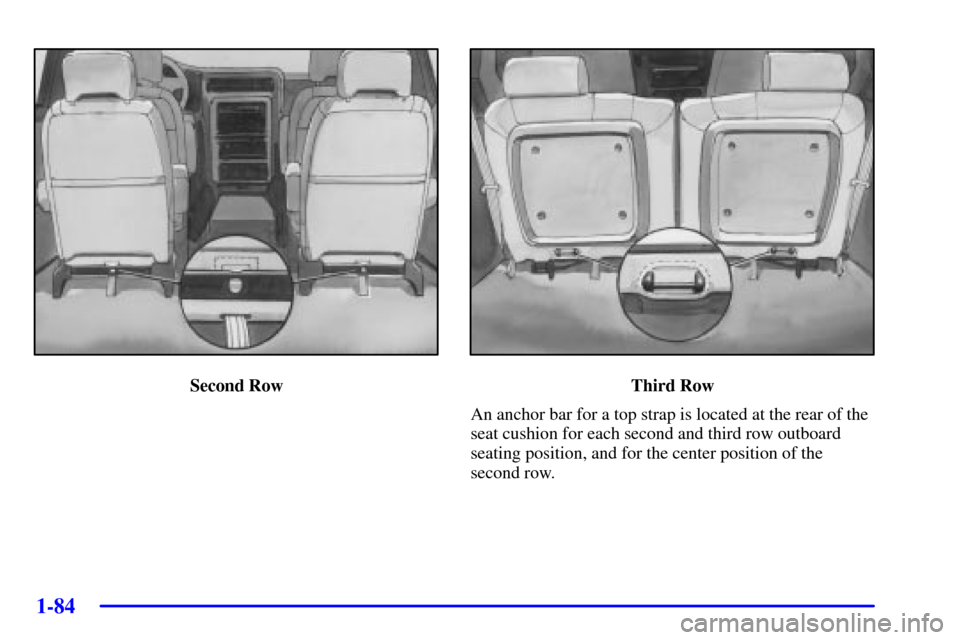
1-84
Second RowThird Row
An anchor bar for a top strap is located at the rear of the
seat cushion for each second and third row outboard
seating position, and for the center position of the
second row.